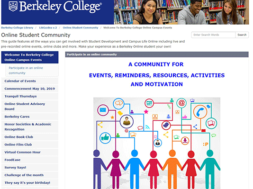
Humanizing Distance Education
By Brittany Nuzzo-Callen, M.Ed., Academic Dean, West Virginia Junior College
Distance education has caused a significant decrease of the “human” element in education. How do you humanize the learning experience in distance education? Focusing on infusing the human element and relationship building even when taught at a distance is the recipe for an effective online community. Together, we will explore various instructional strategies, student engagement techniques and online community development, all with the result of enhancing student retention, satisfaction and achievement within distance education programs. These approaches develop and integrate individualized student-centric strategies, customize content development to maximize course completion and create a monitoring system that utilizes key proactive indicators to optimize results.
Why do individuals choose distance education? Distance education affords students the opportunity to pursue their degree who were unable to do so at a residential campus. Students who are coping with external factors such as child care, careers, transportation, geographic location, etc. now have the ability to fulfill a life-long goal of graduating and earning a degree. The opportunity and expansion of distance education has provided benefits to both institution, student and community. However, benefits like self-paced learning and flexibility are also partnered with an increased attrition rate and numerous boundaries for educators, administrators and other support team members. The boundaries online students experience include, but are not limited to isolation, time management, life circumstance, ability to prioritize, understanding course content and often working multiple jobs.
The institution as a whole must understand their student demographic to construct a strategy that maximizes both student achievement and experience in the virtual environment. Who are the students that we service? If we do not understand our students, their background, goals and obstacles, then we cannot construct a strategy to tailor and enhance their educational experience. The students our institution services have common characteristics which include first time college students, value relationships with their family/friends, struggles with time management skills, often resistant to change, single parents, lack a strong support system and are often employed or working multiple jobs. One of the most important intangible asset to our students is that of their relationships. This could be their relationships with a significant other, children or friends. Relationship construction is a primary, if not the most important theme when humanizing distance education.
The formation, fostering and foundation of these relationships between the institution and student must occur during the early onset of the program and continue throughout the duration until the student achieves their goal of a career.
Now, that we have reviewed boundaries associated with distance education and discussed student characteristics, we must ask, “How can we (the educational facility) provide a superior service that combats the limitations that coincide with distance education?” To bridge this gap, an institution must focus on high touch systems, human elements, effective course design and accountability.
High touch systems are defined as a system of meetings and follow-up that creates frequent and meaningful engagement with students. Establishment of high touch systems involves the evaluation of institution data, high expectations and consistency of meeting structures. To maximize outcomes with high touch systems, we have implemented various elements to aid in this process. One of the data driven elements utilized is that of a “hot sheet.” This attendance document flags students who have not activated their courses for more than three days. This report is generated daily and distributed to programmatic leaders, the career management director and the academic dean. This attendance sheet is reviewed at each weekly meeting. The data is critical as it pinpoints possible student issues which would require proactive planning.
The high touch systems are not only data driven but revolve around coaching and consistent collaboration with team members. The follow-up and follow through begins at the top and filters down. Weekly meetings with programmatic leaders should be held to assist in the “detail” of student progression, regression and academic achievement. These meetings are student-centric and involve a level of questioning by the academic dean and/or campus administrator. Students are monitored on a granular level and are discussed utilizing a stop light system. Students are categorized using (green, yellow or red). These colors indicate advancement or deterioration within an academic spectrum. (Example: A student could be missing work in various courses which would trigger the programmatic leader to utilize this stop light system and engage the student with not only communication but counseling and planning.) The stop light system is a detailed monitoring tool that aids the academic department in servicing online students. The level of detail within these meetings must require questioning techniques revolving around student issues (academic or otherwise). The accountability within departments is reinforced at this time through specificity, questioning and provides a sense of ownership within each program.
High touch systems should continue to be displayed through the virtual classroom with adherence to academic policies like speed to response, speed to return and speed to post. These immediate responses provide a level of connection between the institution and student. Issues, concerns and assessments are directly addressed through a sense of urgency.
Speed to response provides the student with direct contact to administration, program leadership, faculty and technical support.
The individuals affiliated with the institution provide a 24-hour response rate to their students. This response rate provides academic and professional attention to students in real time. This reinforces both relationship construction and frequent interaction.
Speed to return is the return work policy the institution supports. Student work is returned 48 hours from the due date. This policy promotes timely and continuous interaction as well as accountability between the institution, faculty member and student. The student also remains informed with quality feedback and encouragement from faculty members.
Speed to post promotes interaction and dialogue between faculty members and students. It is a best practice that discussion board engagement is checked daily, with faculty members responding to each student’s post at least once. The benefits of speed to response “stitches in” the student to the online community through dialogue. The discussion boards combat the online obstacles such as, isolation, classroom preparation, relationship enhancement and deadline adherence.
These high touch methods are monitored by the institution’s administrator through consistent dialogue and tools like Instructor Insight by AspirEDU. Instructor Insight allows the institution’s administrator to measure items such as frequency of login, faculty engagement (evaluation feedback) and discussion frequency. Reports are generated weekly and sent to faculty members with comments from the institution’s administrator. This reporting system provides the faculty member with data connected to their course in addition to administrative feedback. This is another tool that strengthens accountability within the institution.
The next concept which is one of the most vital in humanizing distance education is that of the human element. Humanizing distance education must individualize the technical education for each student through ongoing human interaction. The programmatic leaders, faculty members, the career management team and technical support analyst must encompass the mission of the institution which is to service students first. When employing individuals it is important to search for those who acquire the intangible attributes which include passion, ability to problem solve, effective communication and the skill to motivate. Education is a human industry, and the individuals who are training and placing our students must acquire these traits. When interacting with the online student, the boundaries and characteristics of the student can become interferences. Communication, problem-solving and addressing barriers must occur in planning prevention by the academic team. This planning prevention reduces attrition through relationship assembly and serves as the key to unlocking humanization. Programmatic leaders (lead faculty, mentors, etc.) must be advocates for their students, lead by example, critically reflect and serve as inspirational models.
After the institution has conquered the employment of their academic leadership, creative refinements can be implemented. Human touch points for students could involve items such as, handwritten birthday cards, weekly faculty calls to students, welcome videos and student shout outs utilizing social media.
These approaches are reminders to the online students that they remain on the forefront of the institution’s mind. It is an underlining theme that “I (the student) matter.”
These types of human elements increase the visibility (remembrance) of the institution, stimulate ongoing interaction and establish enthusiasm and rapport.
Course design revolving around the centralization of content, directions and engagement activities create consistency across courses and programs is yet another element to humanizing distance education. The structure of your learning management system should be user-friendly. The structure of the courses should be developed to maximize consistency with navigation. This provides the students an “I know what to expect,” within the virtual classroom. This allows the user to focus on the content versus. navigation of the system. Although the content is diverse, all courses resemble a similar structure. This consistency combats the online user obstacle of technological frustration and promotes ease of use.
The effectiveness of course materials should contain concise directions, user templates and assessment rubrics. These elements provide the online student with clear expectations as to how to complete each designated task. In addition, supporting information such as narrated lectures, read only Power Points and various supplemental materials should be utilized for student comprehension and review. This strategy provides the online learner with various avenues of course preparation. The benefits of effective course material provide ease of faculty assessment, ease of student completion and diffuse the boundaries of not understanding course curriculum.
Interactive content can promote engagement through various activities. The more entertaining, active and relevant content becomes the greater promotion of student interest and knowledge attainment will occur in the classroom (residential or virtual). The interactive content utilized can include simulations (medical field), interactive lectures and workplace based applications with the focus on both hard and soft skills. The course design component is a contributing and significant factor in humanization.
The final strategy discussed is that of institutional accountability.
It is important that the institution facilitates a culture where faculty and program leadership take ownership of their outcomes and are held accountable for managing the details that other institutions can neglect. Ownership of the programs begin with understanding and reviewing programmatic outcomes (retention, certifications and placement). The objective to meet and inevitably exceed these standards is critical for institutional compliance and above all, student success. To ensure accountability is implemented the institution’s administrator should review data such as (end of module surveys, student satisfaction surveys, externship, graduate and employer surveys.) This data provides insight into the student and graduate experience along with employer feedback. Systematic areas of proficiency and deficiency can be viewed from this information, which is then shared with programmatic leaders on a modular basis. The ownership of each program and student accomplishment must be present at every level (admissions, faculty, programmatic leaders, career management, technical support, etc.) These individuals must believe in the service they are providing.
In conclusion, distance education has evolved and transformed the educational systems in our country. It is important that the adaptation and evolution of distance education is correlated with high touch systems, humanization, effective course design and institutional accountability. To humanize an experience that was constructed on technology, the analysis of obstacles must be combated with the human element which revolves around the concept of constructing, maintaining and thriving on human relationships.
BRITTANY NUZZO-CALLEN is the Academic Dean at West Virginia Junior College Online in Morgantown, West Virginia. Mrs. Nuzzo-Callen earned her Bachelor’s degree from Marshall University in Business Administration and continued her education at Marshall University with a Master’s degree in Education. She has taught both at the secondary and post-secondary levels. Mrs. Nuzzo-Callen was hired by WVJC in 2011 with the charge of establishing and developing the school group’s online division. In her role, she is responsible for curriculum, faculty performance and is ultimately accountable for programmatic and student outcomes. Mrs. Nuzzo Callen currently oversees 450 students, seven program directors and 30 faculty members and an instructional design and technology department. She is known for her great successes in online student retention, which often outperforms most residential campuses. Mrs. Nuzzo-Callen attributes the success to the monitoring of student behaviors and humanizing the distance education student experience.
Contact Information: Brittany Nuzzo-Callen, M.Ed // Academic Dean // West Virginia Junior College// 304-551-2015 // bnuzzo@wvjc.edu // www.wvjc.edu // https://www.facebook.com/WVJCOnline/









